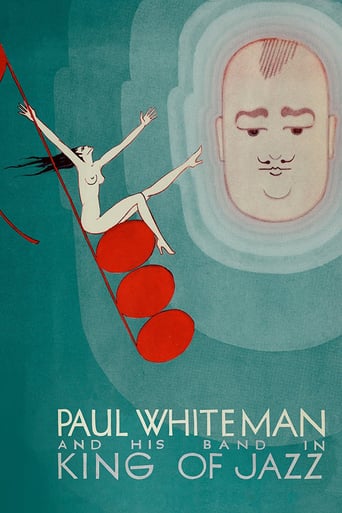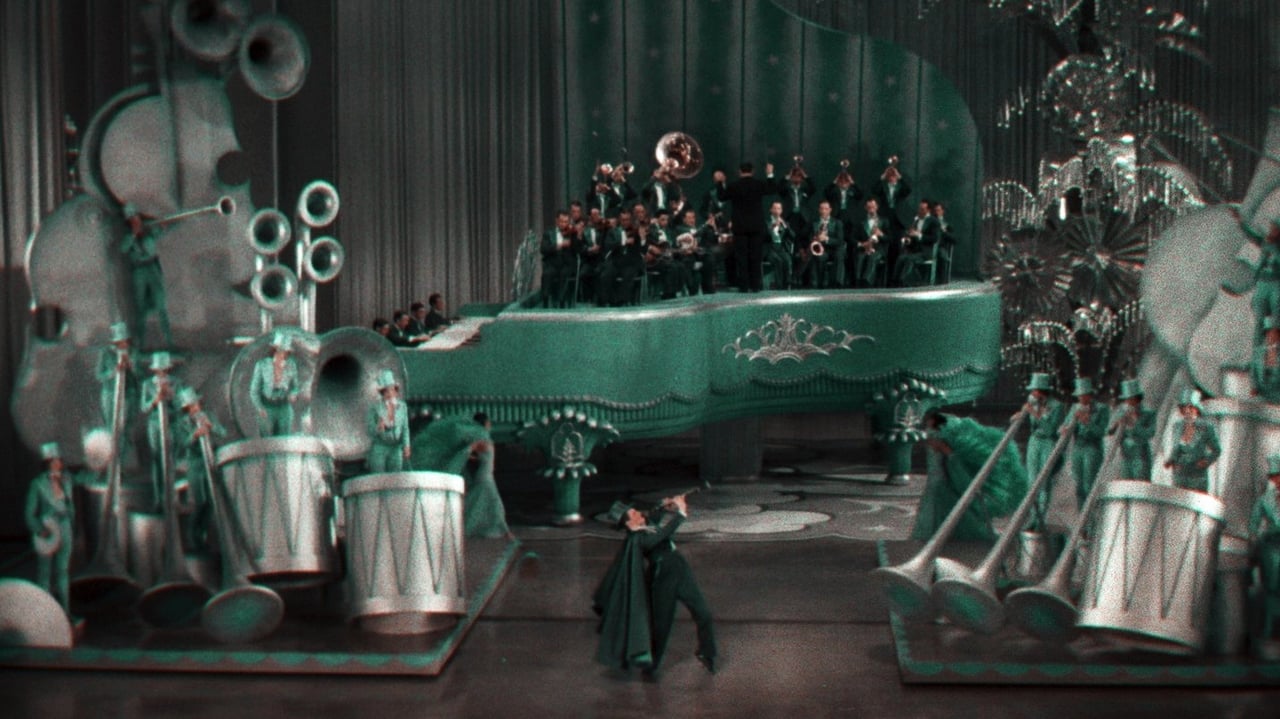writers_reign
It's both impossible and unrealistic to write about this movie - now eighty-seven years old - on anything other than its own terms. One can only try to imagine how lavish it must have appeared to those first audiences, and what is almost unwatchable today - John Boles, for example, is beyond embarrassing in his pathetic rendition of It Happened In Monterrey, which sounds as if he recorded it to a spinet accompaniment, whereas the Sinatra version, itself sixty-one years old, sounds as if it was recorded last week. They also 'lifted' a Peter Arno cartoon from The New Yorker - the one where a couple in a precinct house, the man carrying an automobile seat, ask about reporting a stolen car; for the record this was the freshest sketch on display. Elsewhere we get an early glimpse of Bing Crosby, still one third of the Rhythm Boys, and a reprise of Rhapsody In Blue. It has a certain merit as a time-capsule but that's about it.
kidboots
They called Paul Whiteman the "King of Jazz" - only real enthusiasts knew he wasn't. He was big in every way and by 1922 was making a million a year and it was only natural that when movies found their voice Hollywood would beckon. That was Universal in 1929, Carl Laemmle was seeking a headliner band for a big budget musical. The "Whiteman Special" train bringing the band (including Bix Biederbecke who unfortunately didn't make it on film) from New York to Hollywood was highly publicized with public appearances at every stop but the story writers couldn't come up with a story so the band, who had sat around idle for months, temporarily went back to New York.Whiteman then suggested hiring John Murray Anderson, whose spectacular New York revues had made him Ziegfeld's closest rival and his futuristic and inventive influence made him the real star of the movie. There are so many tantalizing stories - Bing Crosby was all set to be the lead singer with the songs "It Happened in Monterey" and "Song of the Dawn" (a dazzler sang with a cowboy chorus) handed to him but he was involved in a drink driving incident in which he was sentenced to 60 days which was converted to a 40 day furlough but still saw the songs handed to John Boles who vocally was much better suited with his fruity tones. Years later in a documentary Crosby felt Boles carried the songs far better than he could have. Another story involved Jeannie Lang whose Helen Kane rendition of "Ragamuffin Romeo" and "I Like to Do Things For You" had preview critics raving but she had already been cut out of the soon to be released movie so editors had to quickly splice her back.The film begins with Bing Crosby singing "Music Has Charms" over the credits (one song that Crosby retained) and after an animated cartoon (the first in colour) showing how Whiteman became "King of Jazz" he steps out to introduce "his boys" - there's Joe Venuti and Eddie Lang playing a marvellous duet and a startling shadow looming down on banjoist Mike Pingitore as he strums "Linger Awhile". Then it's "the girls" turn and the marvellous Rockettes dressed in spangley peach and silver go into a precision formation dance and show why they became legends.Colour lends such a beauty to the "Bridal Veil" number with gorgeous displays of bridal gowns through the ages. Jeanette Loff (with the longest bridal train ever) looks as pretty as peaches and cream and sings very prettily too. Next are the fabulous Rhythm Boys who come out of the shadows of "Mississippi Mud" to sing a "super, super, special kind of production" (Harry Barris's words) of "When the Blue Birds and the Black Birds Get Together". Bing's sense of humour and comic timing is so spot on even though he was still only one of the Rhythm Boys. "A Bench in the Park" features Stanley Smith and Loff as a pair of lovers, joined in harmony by the Brox Sisters accompanied by the Rhythm Boys then "the girls" get together for a dance that was obviously the inspiration for "Pettin' in the Park". "Rhapsody in Blue" is just awesome, initially showing Jacques Cartier in a futuristic setting beating out rhythms on a huge drum. This sequence was supposed to have cost $500,000 with a huge centrepiece of a gigantic blue grand piano, the Paul Whiteman Orchestra inside, dancing girls on top of the keys, a kaleidoscopic effect of dazzling blue feathers and flowers. WOW!!Where do you start with "Happy Feet" - from a pair of dancing shoes, the Rhythm Boys giving it their unique interpretation (with plenty of piano banging) the Sisters G are shown singing with their heads reflected against a shiny silver surface below - very psychedelic, they then give an all too brief but spirited dance, then the Rockettes dance out of a New York skyline to do another precision tap, then Al "Rubberlegs" Norman takes centre stage to do another of his dazzling eccentric rubberlegs routine!! and lastly Paul Whiteman (or his double) has a go at a vigorous Charleston. "Ragamuffin Romeo" is another "eccentric" dance with Marion Stattler whose gymnastics have her being thrown around like a rag doll."The Melting Pot of Music" is almost too much with a succession of sounds and images, dances and countries (strangely no mention of the African American) which then blended into the finale. Interspersed throughout the film were comedy hot spots but unlike other reviews of the time, they were short, snappy and not labored and with the clear print you were able to recognise the stars (Laura La Plante etc). Another reviewer mentioned a preference to "Hollywood Revue of 1929" but I'm sorry for me there is no comparison. This was a true spectacle enhanced greatly by colour and showcasing legends of the music world, to say nothing of Paul Whiteman's ease in front of the camera, the other just relied on movie stars out of their comfort zones being able to bring in a curious public.Highly Recommended.
earlytalkie
What true film buff would not love "King of Jazz"? This film was really quite advanced for an early talkie. The photographic effects are marvelous, from Paul Whiteman's band coming out of a small suitcase to the shadow effect in the "Voodoo Drum Dance" to the Melting Pot montage, there was some real imagination at work here. It is so pleasant to see one of the few remaining two-color Technicolor features. It is fun to see Bing Crosby in his first feature film appearance. The "Rhapsody in Blue" sequence is also impressive. It is a shame that Universal has not seen fit to give this film a proper release on DVD, but I managed to locate a very good quality DVD at a decent price. A beautiful film revue from the early days of sound film with Oscar-winning sets and wonderful music. The tagline for this film reads: "Once in a lifetime...a show like this!"
Spuzzlightyear
I oh so wanted to see this film desperately after seeing the awesome trailer for it. I mean, a two color musical, the first ever made for Warner Brothers! The King Of Jazz has no plot. Nada. Nil. Instead it's a whole pile of musical numbers and comedic skits. The whole thing is centered around a guy who was popular at the time, Paul Whiteman, and his orchestra. The one thing I really liked about this movie is the set design. THAT was truly gaga, but soon lame musical number after lame musical number envelops what good that does and makes this an AWFULLY uncomfortable sit through. Well, at least we got to see a very very young Bing Crosby. That's about all that makes this watchable.


 AD
AD






